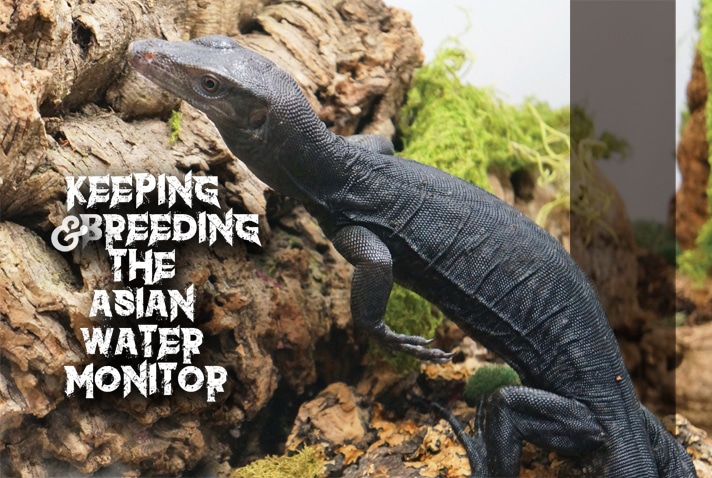Captive breeding of Varanus salvator has increased the popularity of this beautiful lizard.
Asian water monitors (Varanus salvator) are truly majestic and intelligent lizard giants, earning them a loyal following in the reptile trade. This species hails from southern and Southeast Asia, where they’ve evolved over millions of years to survive in both wild and urban settings through their many adaptations. While their husbandry requirements can be challenging, many hobbyists are rising to the challenge and discovering how truly rewarding it is to share your home with an “Urban Dinosaur.” Keepers are also experiencing the true social and intellectual capacity of these lizards, guided by their extreme intelligence and ability to form bonds. Here we hope to contribute to quality husbandry with reptile supply recommendations and tips.
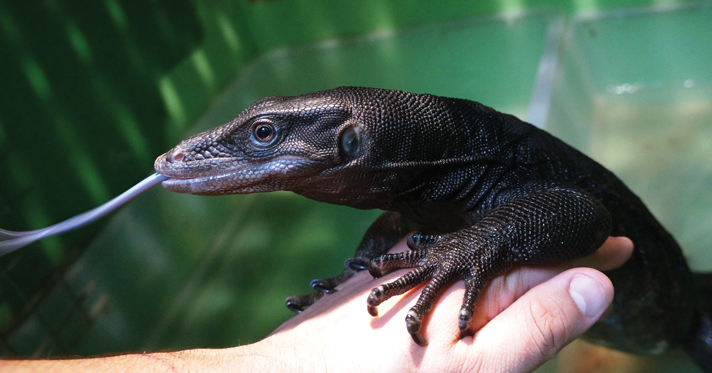
Joshua Ortiz
Captive breeding of the Asian water monitor has resulted in a range of unique species sporting differing colorations.
In recent years captive breeding has expanded, bringing to the market a range of unique specimens both in personality and appearance. Captive breeding has allowed us to pair the hallmark of a tame manageable monitor with the undeniable beauty of morphs and selective breeding, making them one of the most impressive and rewarding animals available to keepers. Observing these animals in their native range is further evidence of their incredible ability to not only survive, but thrive in varying and often difficult environments.
The Asian Water Monitor’s Natural Range
The vast range of water monitors is a testament to their remarkable ability to adapt. They’re found as far north as Northeast India and all the way down to the insular regions of Southeast Asia. Within these regions, they have proven to flourish in a variety of landscapes throughout this range, including urban settings such as the metropolis of Bangkok, Thailand! Although Varanus salvator are considered a lowland species, they have been found at elevations as high as nearly 6000 feet above sea level. This species is harvested in large numbers for their leather, body parts and meat throughout much of their range. The successful expansion of this semi-aquatic lizard can be credited to many of their unique adaptations, including their intelligence and size.
Asian Water Monitor Size/Description
Asian water monitors are regarded as the third longest lizard after the komodo dragon (Varanus komodoensis) and the crocodile monitor (Varanus salvadorii). The longest water monitor on record was a specimen from Sri Lanka measuring an impressive 10.5 feet long! They have a truly astounding growth rate, even seasoned keepers are still surprised at the gains these animals can make in a short period. Hatchlings will start out at about 10 inches long and will potentially grow several feet in a single year under optimal conditions. Ultimately, the adult size of a water monitor depends on several factors including their genetics, locality, diet, and husbandry parameters. Being a sexually dimorphic species, males typically dwarf females and will range from 5-8 feet once full grown. Females are considerably smaller, normally maxing out at approximately 4-6 feet. There are certainly cases where water monitors have surpassed this size, but such cases are considered exceptional.
Along with their large size, water monitors have a life expectancy of at least 15 years, possibly up to 20+ years in captivity due to modern advances in reptile keeping. Housing an animal that can attain this large size can pose a challenge. Fortunately, there are many enclosure options available to keepers.
Asian Water Monitor Enclosures
The immense size of an adult water monitor is simultaneously one of the most impressive and most challenging aspects of their care. A hatchling monitor can initially be housed in an enclosure with the size equivalent to a 40 gallon reptile terrarium (dimensions of 36”x18”x16”). There are commercially available alternatives to glass tanks readily available, as an actual tank is not recommended because glass enclosures often do not adequately maintain the temperature and humidity required.
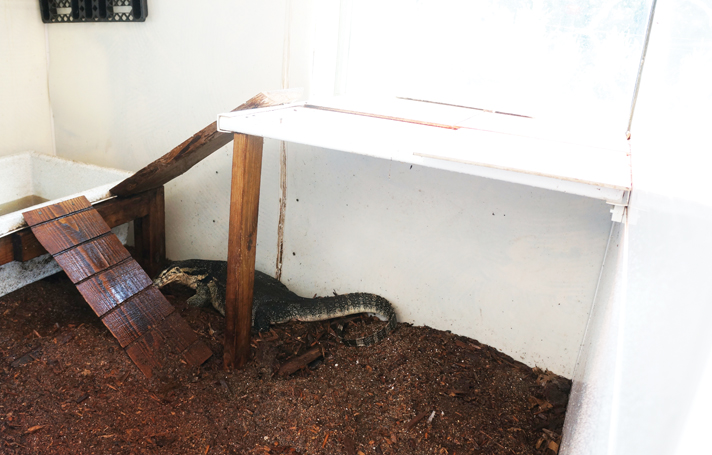
joshua ortiz
Enclosure for a single large adult.
For yearlings, a custom enclosure measuring 4’x4’x4’’ is sufficient, and adults will need to be upgraded to an enclosure approximately 8’x6’x8.’ When decorating an enclosure with lizard habitat products, it is particularly important to utilize vertical space as this will increase the surface area available for the lizard. Varanus salvator are an active species and are avid climbers, therefore, having a well-furnished enclosure for them to explore will benefit both their physical and mental well-being. Caution must be exercised when opting to use fragile decor like live plants, as such items can oftentimes be easily damaged even by a gentle giant. Vertical space however can be created by including items such as branches, shelves, and logs as basking areas.
Reptile Heating & Lighting
Properly heated monitors should bask for a limited time, then explore their enclosure before returning to the basking area, a true example of thermoregulation. This cycle should be repeated throughout the day. If a monitor is spending an inordinate amount of time basking, then the basking and/or ambient temperatures may be too low. Conversely, if a monitor lizard is never basking then this may be because temperatures are too high. Correct temperatures in conjunction with correct humidity are two significant factors in maintaining a happy, healthy animal. Reptile timers can be used to monitor these conditions.
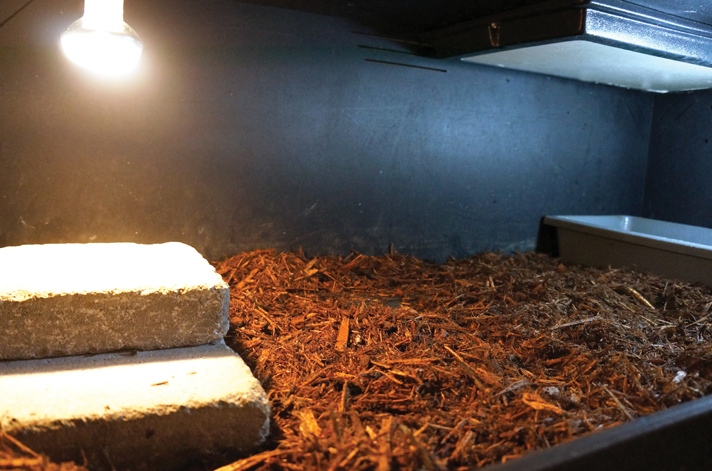
joshua ortiz
Basking is extraordinarily important for all monitor lizards as they are dependent on external heating to help regulate their metabolism.
Basking is extraordinarily important for all monitor lizards as they are dependent on external heating to help regulate their metabolism. The temperature of the basking surface area should fall in the range of 125-140º F. Floodlights are often the basking bulbs of choice since they generally achieve higher temperatures at lower wattages over a larger surface area compared to conventional basking bulbs. Placing numerous bulbs in a bank positioned parallel to one another is best for larger monitors to adequately heat the entire animal during basking. This will help avoid burns as the monitor will be able to achieve their ideal temperature in a reasonable time period. Monitors must be provided a cooler area as well, where the reptile can retreat to cool down, as this is critical during digestion where body temperatures can rise due to metabolic activity.
Water monitors generally reside in regions close to the equator where temperatures typically do not fluctuate significantly throughout the year. Therefore, ambient temperatures in their enclosures should be maintained in the low to mid 80º Fs. Although temperatures can be allowed to drop slightly at night within reason, many keepers perpetually maintain conditions constant with great results. When adequate temperatures are combined with a large water reservoir, the humidity levels in the enclosure will rise.
Proper Humidity for Your Asian Water Monitor
Varanus salvator relish the water and normally are found near bodies of water such as mangrove swamps in the wild. Captive water monitors require a water reservoir large enough for them to fully submerge in. The cleanup associated with water monitors is directly correlated to water changes since monitors will often urinate and defecate in the water. Therefore, once the water is replaced the majority of cleanup is completed. Daily water changes are recommended unless strong filtration is set up. Caution must be exercised when setting up filtration, of course, as strong suction can cause a monitor to become trapped and drown. Placing an adequate size water reservoir also helps elevate humidity levels in the enclosure.
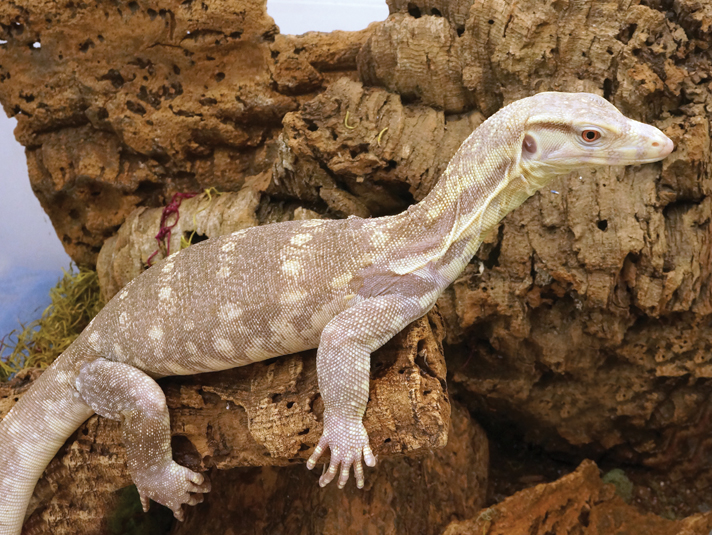
joshua ortiz
Varanus salvator large male juvenile T+ albino half way through color change.
Humidity levels around 60 to 70 percent are perfect as overly humid conditions can lead to health issues like scale infections. Stale wet air can lead to fungal and bacterial lesions that can overcome the animal’s immune response. There are many commercially available thermometers and hygrometers on the market to record temperature and humidity accurately. Practicing proper husbandry is of the utmost importance for all animals. Unfortunately, some hobbyists do not anticipate the care requirements of large lizards and some water monitors are surrendered and rehomed as adults. This is why it is important to be prepared for the commitment of keeping a large carnivore that will require a lot of space and food.
Asian Water Monitor Diet
Large lizards have huge appetites! It’s recommended that hatchling water monitors are fed daily to every other day for their first year of life. This will be the period of time when the most growth occurs and the diet needs to provide the necessary nourishment for extreme growth. A well-fed lizard may not be interested in feeding for a few days while smaller frequent feedings may yield a constant appetite. Baby monitors tend to be highly insectivorous and their captive diets should reflect this; a diet comprised primarily of gut loaded crickets and varying species of roaches are a good choice. In addition to gut loading, it is also important that insects are dusted with a calcium/Vitamin D3 supplement before being offered to the lizard. This is important to add to your lizard food.Growing monitors can gradually be transitioned to whole prey items, such as appropriately sized rodents, fish, and poultry. Yearling monitors can be fed whole prey items about three to four times weekly, while full size adults over two years old can be fed less frequently, typically two to three times weekly. It is important to remember that water monitors are opportunistic feeders and will rarely refuse a meal. This voracious appetite means adult water monitors are prone to obesity in captivity and that can result in a host of health issues, ultimately resulting in a shortened life expectancy. After a meal, monitors will bask to help digest their food, so again it is important to ensure your enclosure has proper temperatures and ample basking area.
Choosing a Water Monitor
Once your enclosure is set up and you are prepared for the task of feeding your urban dinosaur, it’s time to choose your water monitor. A captive-bred specimen is always recommended over a wild-caught animal, as they will be socialized much more easily without the trauma of capture and export. Monitor lizards hand raised in captivity also tend to be more innately tractable and well-socialized when provided with proper care. There’s also health risks with wild-caught animals, such as parasites or foreign contaminants. Acquiring a healthy water monitor is of the utmost importance.
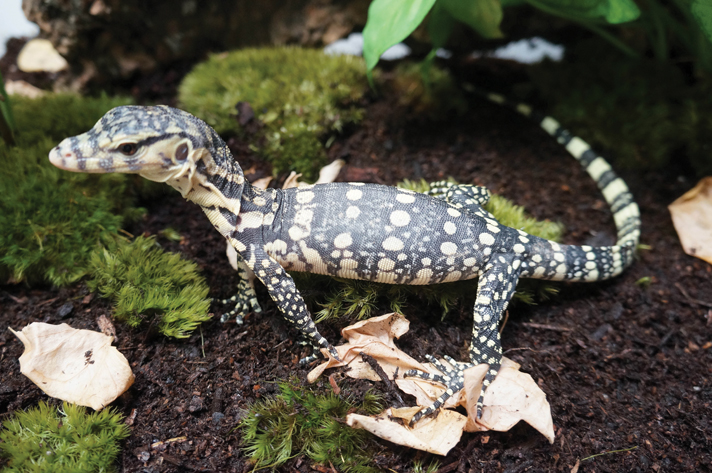
joshua ortiz
When choosing an Asian water monitor, look for robustness, clear eyes and no excessive secretions from the nose and mouth. Choose captive bred reptiles as they are healthier.
When you choose your animal there are a few tips that can assist you in choosing a healthy specimen: You should choose an animal that appears robust and active, with open clear eyes and no excessive secretions from the nose or mouth. Keep in mind that an inactive animal may appear more “friendly,” but this lack of vigor could potentially indicate health issues. There are currently some reputable breeders of Varanus salvator, making acquisition of a healthy, hand-raised specimen practical for all expert keepers. Maintaining a healthy animal will of course significantly reduce stress for both keepers and their clever monitors.
Socializing Asian Water Monitors
Intelligence is undoubtedly a hallmark of the monitor lizard; millions of years of evolution has armed water monitors with the intelligence to adapt and survive in a myriad of environments. In captivity, this extreme intelligence has allowed keepers to socialize our animals and establish relationships that previously weren’t considered possible.
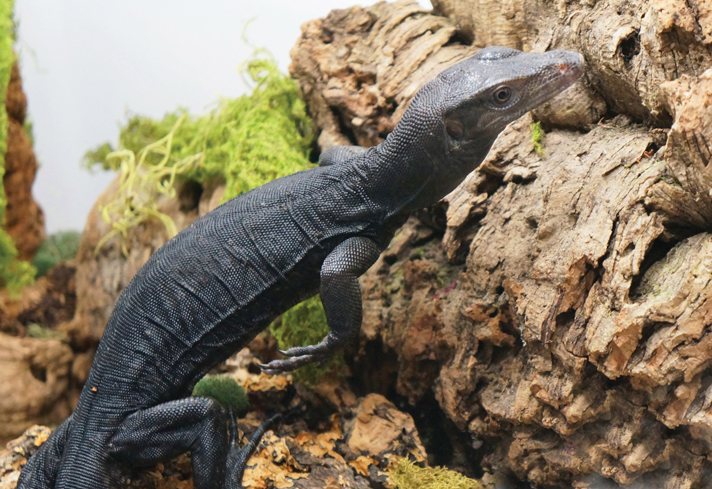
joshua ortiz
Socializing an intelligent lizard is actually quite practical, the key is to have consistent short and positive interactions.
Viewpoints on monitor lizards have shifted over the years due to advances in keeping, understanding and the availability of captive-bred animals. Varanus salvator are now typically regarded as “gentle giants,” rather than unpredictable and difficult to handle. Facilities such as New England Reptile Distributors (NERD) have made great strides in socializing this species and understanding their potential. They utilize techniques to establish trust with captives and have been able to demonstrate learned methods. Socializing an intelligent lizard is actually quite practical, the key is to have consistent short and positive interactions. The lizard should be approached from underneath as gestures from above can be seen as threatening, especially for a hatchling that would be predated on regularly in the wild. Just like many other species, they have evolved to be fearful of approaches from above. There may be hesitation on the part of the animal initially but the key is consistency. Approach the monitor from underneath with calm, yet deliberate motions. Performing such actions in shallow water often helps as well, since monitors are naturally more confident and calm in water. Gradually, the animal will associate the keepers hands with positive interactions. With time and patience this simple technique will aid in having a large, gentle beast to enjoy for years to come.
Breeding Asian Water Monitors
The captive breeding of monitors has been accomplished on several occasions but a limited handful of breeders, besides NERD, have had regular success. Naturally, water monitors are a prolific species, but emulating conditions for successful propagation in captivity can be challenging. First, having a properly sexed pair of monitors is necessary. This initial step can prove difficult even for experienced keepers. Mature male water monitors generally are larger with bulkier and broader snouts. Additionally, adult males usually have pronounced hemipenal bulges and will occasionally evert their hemipenes even when not breeding. Females are relatively petite with slender and pointy snouts. Once a properly sexed pair is identified they can potentially be paired together.
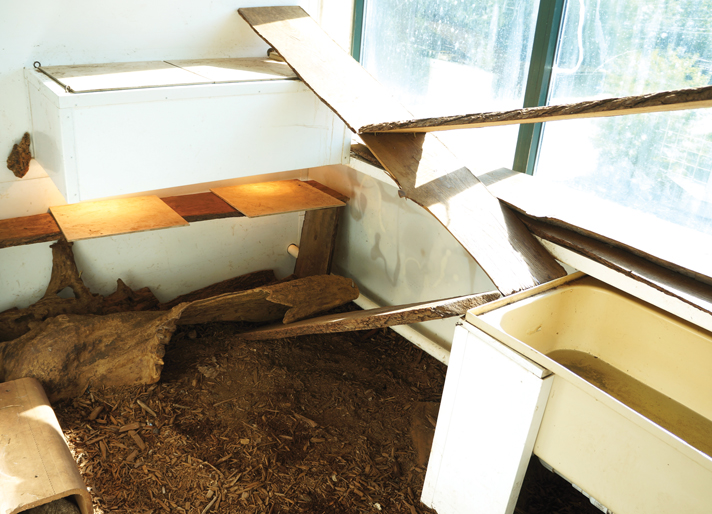
joshua ortiz
A breeding enclosure. There must be deep substrate of proper composition and consistency present in order to increase the likelihood of successful nesting.
Breeding pairs of water monitors will require a large enclosure measuring at least 8’x8’x8.’ Properly fed females kept under correct husbandry parameters can cycle several times a year and it is important to recognize when a female is cycling. Females tend to have strong appetites and feeding responses while cycling in an attempt to increase their caloric intake in preparation for potentially becoming gravid. Since females tend to have regular cycles, scheduling breeding based on the last time she laid eggs is also possible. The preferred monitoring method at our facility however is ultrasounding female water monitors. Ultrasounding takes the guesswork out of breeding. When a female possesses optimally sized follicles, in the 15-25mm range, a male is paired with her. If she is receptive and copulation is successful, she may become gravid and will lay eggs approximately 30-45 days later.
Incubating Asian Water Monitor Eggs
Depending on the age and size of the female, clutches range between six to 18 eggs, although more or less is not uncommon. There must be deep substrate of proper composition and consistency present in order to increase the likelihood of successful nesting. Females prefer their nesting site substrate at 86ºF, and will spend several days digging “test holes” until she finds a suitable nesting location. In a correctly maintained enclosure, meeting such requirements should be straightforward. Once the female has laid her clutch, the eggs are placed in a plastic container filled with hatchrite media and incubated at 86ºF. At this temperature babies will begin to hatch in six to seven months. Hatching baby water monitors is truly one of the most rewarding experiences as a reptile keeper.
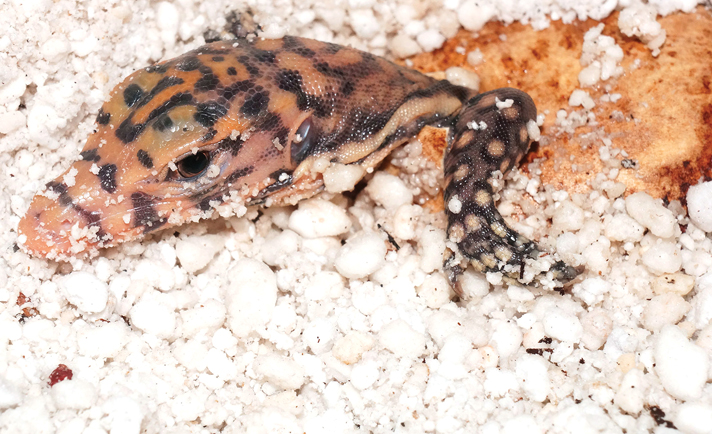
joshua ortiz
A baby sulfur hatchling.
Availability/Captive Asian Water Monitor Morphs
Years ago, it was virtually incomprehensible that we would one day have the mutations and line-bred Varanus salvator we have today, resulting in an entire spectrum of stunning animals. There are several mutations/morphs now available in captivity.
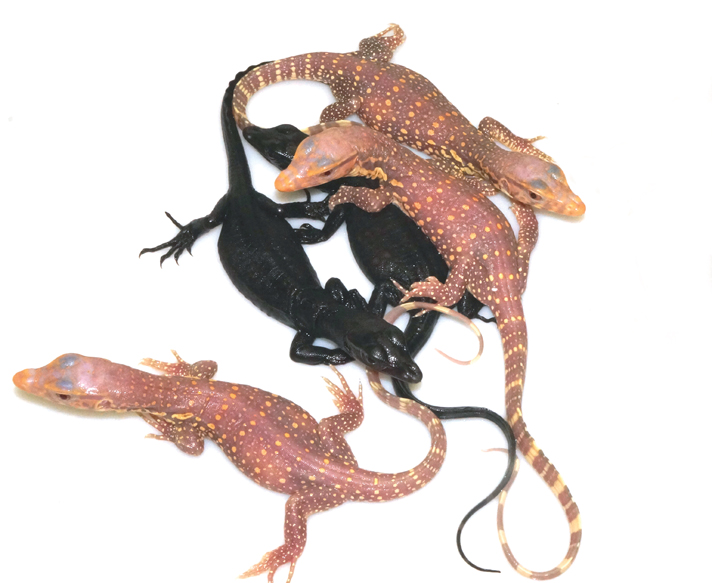
Joshua ortiz
Varanus salvator hatchling T- albino and black dragons.
T- (tyrosinase negative) albino water monitors or “true albino” water monitors are regarded as the most rare and sought after morphs in the hobby today. T- water monitors lack the enzyme tyrosinase that is critical for melanin production. T+ (tyrosinase positive) albino water monitors or “partial albino” water monitors have partial functioning of tyrosinase and consequently are born with a reduced amount of melanin that dissipates over time. Therefore, a T+ hatchling water monitor may appear quite dark as a baby having a purplish hue that will gradually become lighter with age. Adult T- and T+ water monitors look nearly identical as adults in most cases, but a distinguishing characteristic that separates the two is eye color. The T+ animals have a darker eye color, while T- animals exhibit reddish color which is typical of albino animals. Hyper melanistic water monitors or “black dragons” are a naturally occurring heritable color phase. Black dragons from the Thailand locality, generally are referred to as the subspecies komaini. Another stunning heritable color variation would be the Sulfur water monitor. Sulfurs tend to be saturated with yellow coloration and often have banding down the back. These four variations encompass some of the most popular options currently available. There are several other varieties that are currently being worked with in the U.S. and abroad.
The Future of Varanus salvator in Captivity
We’ve only begun to scratch the surface of the potential that water monitors possess. They have proven to be magnificent captives. Although their requirements may be a bit of a challenge, if you rise to the occasion, you will be rewarded with an intelligent and captivating reptile. Captive propagation has resulted in some of the most impressive color mutations available, and the future of combining these mutations is still ahead of us. As our understanding of water monitors grows, we will continue to see their popularity grow.
Joshua Ortiz has kept Asian water monitors for more than 20 years. Currently, he serves as the Head of Operations for NERD, owner of Herpetofauna by Josh Ortiz, and co-host of the podcast “Lizard Hour.” Visit the NERD website.
Lizard Hour link here.

